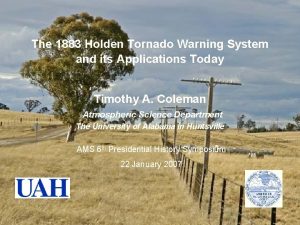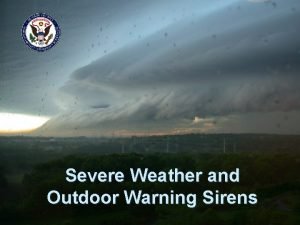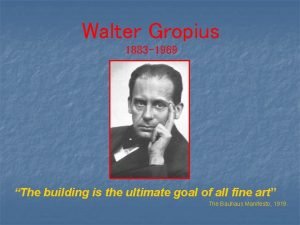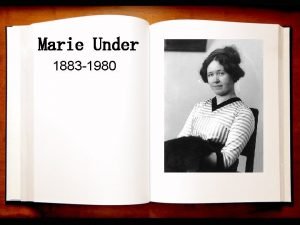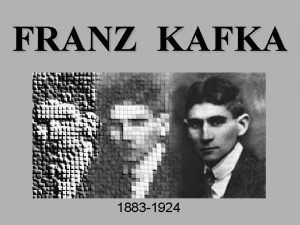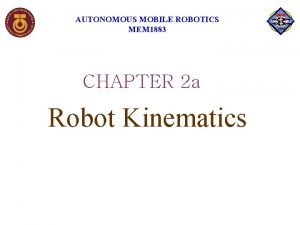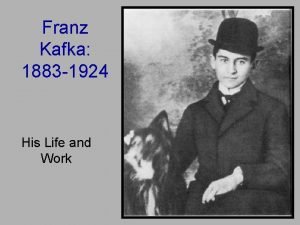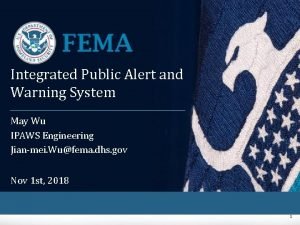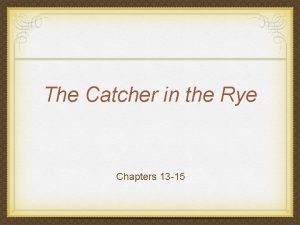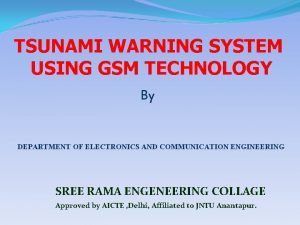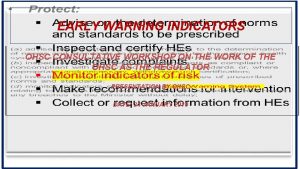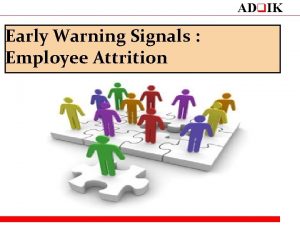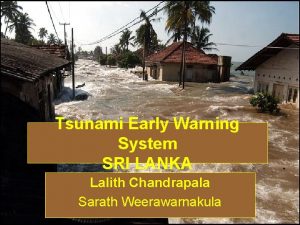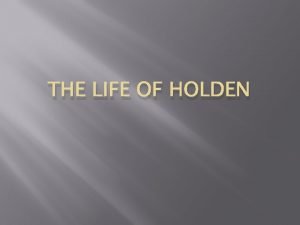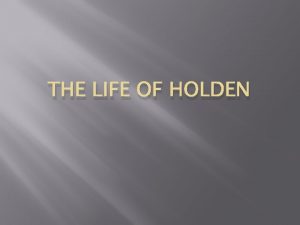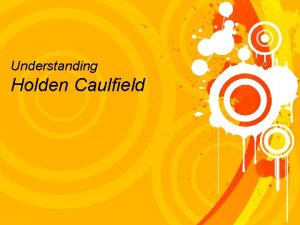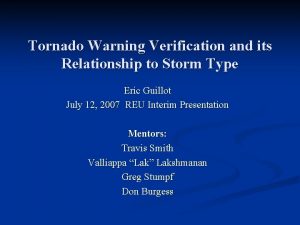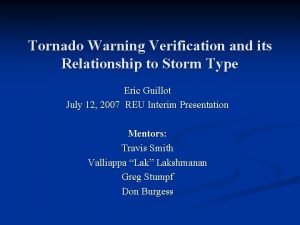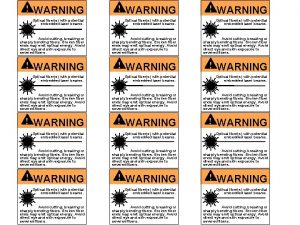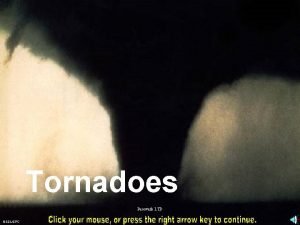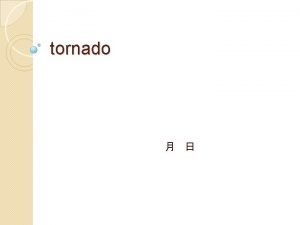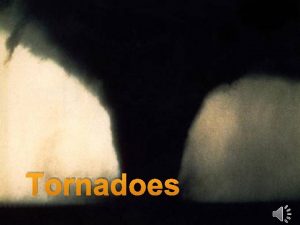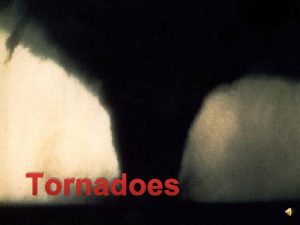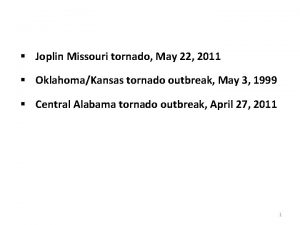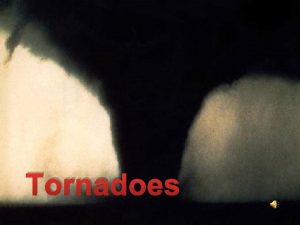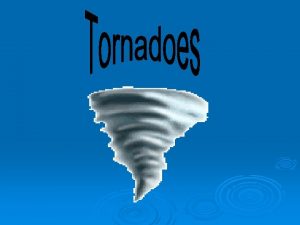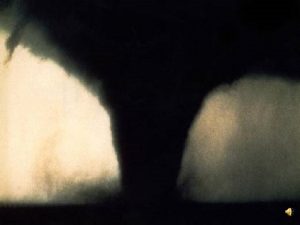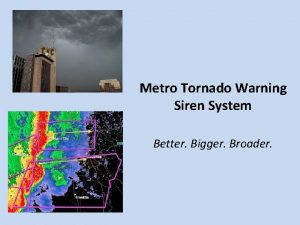The 1883 Holden Tornado Warning System and its



























- Slides: 27

The 1883 Holden Tornado Warning System and its Applications Today Timothy A. Coleman Atmospheric Science Department The University of Alabama in Huntsville AMS 6 th Presidential History Symposium 22 January 2007

1. Introduction • During the latter part of the nineteenth century, tornado deaths (per capita) were high by modern standards • Even though the number of days per year with at least one significant tornado in the U. S. has remained fairly constant (Grazulis 1993) since 1880, the number of tornado deaths per capita has greatly decreased, partially due to tornado warnings (Howard, SD, 1884, NOAA)

1. Introduction (Brooks 1998)

1. Introduction • In 1882, Sgt. John P. Finley of the U. S. Army Signal Corps weather program (known as the “Division of Telegrams and Reports for the Benefit of Commerce and Agriculture” headed up a program to document and understand local storms, including tornadoes. • About 1000 “reporters” were organized in the central and eastern U. S. to report tornado occurrences and damage (Bradford 1999). Mon. Wea. Rev. , 1, 1. (NOAA library)

1. Introduction • By 1884, Finley outlined the general weather patterns associated with tornadoes. • Using these patterns, along with weather observations, Finley began to issue “tornado alerts” for large areas (on a scale similar to tornado watches today) beginning in March 1884, to some degree of success (e. g. , Bradford 1999; Schaefer 1986). Sig. Corps. Station c. 1888 (NOAA library)

1. Introduction • Upon examination of Finley’s findings, Edward S. Holden, in the journal Science in 1883, proposed a tornado warning system for towns, utilizing telegraph lines and basic knowledge of electrical circuitry. • Despite Finley’s success, and calls from The Chicago Tribune in 1899 for local tornado warnings, the Signal Corps. banned the use of the word “tornado” in its forecasts starting in 1886. • This policy remained in effect until 1938, well after the nation’s weather services were placed in the civilian U. S. Department of Agriculture in 1890 and would become the U. S. Weather Bureau (Bradford 1999; Galway 1984). • Meteorologists of the time felt that tornado forecasting and warnings would cause undue panic and was impractical (e. g. , Hazen 1890; Abbe 1899)

1. Introduction • To the author’s knowledge, Holden’s system was never put into effect in a town. • However, not only is it a fascinating system, but three aspects of the system are still, indirectly, in use today, including: 1. Power transmission line lockouts as indicators of tornadoes 2. NOAA Weather Radio 3. Outdoor tornado sirens

2. Holden’s Tornado Warning System • Edward S. Holden’s main research work was in the field of astronomy. • Worked for U. S. Naval Observatory and as librarian of the U. S. Military Academy at West Point, New York • He was also the president of the University of California, and director of its Lick Observatory (Campbell 1916)

2. Holden’s Tornado Warning System • According to Holden (1883), saving property from a tornado was not feasible. However, he pointed out that lives may be saved if people were given five minutes’ warning to utilize underground shelters. • Holden pointed out two findings made by Finley (1884): 1) Most tornadoes approach from the W to SSW 2) Their average speed was about 30 mph. • Using these findings, he proposed a system to provide warnings of tornadoes to towns.

2. Holden’s Tornado Warning System • An arc of telegraph wire was to be constructed from the W through SSW directions of a town, at a radius of 2 to 2. 5 miles. • The line would be connected to a battery in the telegraph office, sending constant current through the line. • The telegraph line would also have connections in people’s homes, to an apparatus containing a bell which rings using a coiled spring (similar to an alarm clock), but kept from ringing by a magnet as long as current runs through the wire. • A similar device could be connected to a cannon, which would fire (in lieu of a ringing bell) • If the circuit were broken, the bells would ring in homes and the cannon would fire.

2. Holden’s Tornado Warning System • The general idea is that the circuit would be broken by high winds, presumably from a tornado, approaching the town from the SW.

2. Holden’s Tornado Warning System • To create a circuit which would be broken in the event of tornado winds, Holden proposed that the circuit would pass through an iron rod connected to a wooden board, which would freely revolve about another iron rod. • The iron rod connected to the board would then be connected through a thin wire to a pin on the telegraph pole, then continue to the next pole. • The thin wire would be such a strength that a certain force of wind on the board (Holden proposed 70 mph) would break the wire, and therefore the circuit.

2. Holden’s Tornado Warning System • Holden points out that details of the system may be left to individuals. • He constructed a working example of such a device in his laboratory.

2. Holden’s Tornado Warning System • To the author’s knowledge, Holden’s system was never put into effect in a town. • However, not only is it a fascinating system, but three aspects of the system are still, indirectly, in use today, including: 1. Power transmission line lockouts as indicators of tornadoes 2. NOAA Weather Radio 3. Outdoor tornado sirens

3. Power Transmission Line “Lockouts” • The power grid in the United States consists of thousands of miles of high-voltage transmission lines • These lines reduce the current needed to transmit large amounts of power over long distances, increasing efficiency • These transmission lines feed lower-voltage distribution lines, which bring power into our homes and businesses.

3. Power Transmission Line “Lockouts” (Idaho Power Company)

3. Power Transmission Line “Lockouts” • The major transmission lines are typically placed in areas where downed trees can not affect them, often on land that is kept clear of significant plant growth • Their location and design makes these lines resistant to all but extreme winds, generally those caused by a tornado • These lines contain circuit breakers, designed to trip in the event of temporary surges or short circuits, then reset automatically after a short period of time (Hooks 2007)

3. Power Transmission Line “Lockouts” • If the major lines or their towers are damaged by a tornado, a more permanent short circuit is created, and the circuit breaker can not reset. • This is known as a “major line lockout”, and its approximate location can be detected by the power company and relayed to the National Weather Service. • These lockouts provide strong evidence of a tornado. (rain. org)

3. Power Transmission Line “Lockouts” • If the NWS detects any type of rotation on Doppler radar in the area of the lockout, a tornado warning is nearly automatic in many offices (Peters 2008). • Similar to the Holden (1883) system in that broken electrical lines indirectly provide a tornado warning (Geological Survey of Alabama)

3. Power Transmission Line “Lockouts” • If the storms west of Birmingham, in southern Walker County, showed only weak signs of rotation, but the 230 k. V transmission line between Gorgas Steam Plant and Tuscaloosa was “locked out”, a tornado warning would likely be issued.

4. NOAA Weather Radio • Prior to 1974, 50 -60 radio stations were operated by the National Weather Service, providing continuous weather information, primarily in coastal areas. • In response to the Super Outbreak of Tornadoes across the central and eastern United states in April 1974, Congress appropriated the money to expand the network to 330 stations, forming the NOAA Weather Radio network that is still being expanded today (NOAA, 1999). • NOAA Weather Radio was also designated under a 1975 White House Policy Statement as the only governmentoperated radio system to bring weather warning information directly to American homes.

4. NOAA Weather Radio • In the event of a tornado warning, a 1050 Hz tone is broadcast, which activates specially-designed receivers to sound an alarm • Today, with Specific Area Message Encoding (SAME), an additional set of tones is broadcast, which activates only receivers in the areas affected by a given weather threat. • The Weather Radio receiver in each home serves the same purpose as the ringing bell in Holden’s 1883 system (NWS)

4. NOAA Weather Radio • In the event of a tornado warning, a 1050 Hz tone is broadcast, which activates specially-designed receivers to sound an alarm • Today, with Specific Area Message Encoding (SAME), an additional set of tones is broadcast, which activates only receivers in the areas affected by a given weather threat. • The Weather Radio receiver in each home serves the same purpose as the ringing bell in Holden’s 1883 system

5. Outdoor Tornado Sirens • During the Cold War era, in response to fears of nuclear attack, the Federal Civil Defense Act of 1950 led to public warning systems (Victory. Siren 2003). • Outdoor warning sirens were placed in many areas of the United States. • Eventually, once the Cold War came to and end, the sirens were used almost exclusively as tornado sirens. (Civil Defense Museum)

5. Outdoor Tornado Sirens • These outdoor warning sirens are similar to Holden’s (1883) idea of firing a cannon to warn people outdoors of the approach of a tornado. (youtube. com, “Mackinacmac”)

6. Summary • In some ways, Holden was 50 -75 years ahead of his time in devising an automatic tornado warning system in 1883 which would not only detect the tornado, but warn people in individual homes and outdoors of its approach. • Unfortunately, due to the resistance of the Signal Corps and the Weather Bureau to tornado forecasts or warnings, Holden’s system was never widely used • However, many of the concepts Holden developed in his tornado warning system are in use today, 125 years later.

6. Summary • Major line lockouts, caused by the destruction of power transmission equipment, are detected remotely and usually indicate the presence of a tornado. The knowledge that a major line lockout has occurred is used in modern National Weather Service offices to help issue tornado warnings. • Holden’s idea of an alarm system within every home became available in 1975, when the NOAA Weather Radio network was expanded. • Holden’s idea of having a cannon fire to warn those outdoors of an approaching tornado is similar to the tornado sirens which have been warning people of tornadoes for decades.
 Holden tornado
Holden tornado Dupage county tornado warning
Dupage county tornado warning Walter gropius 1883-1969
Walter gropius 1883-1969 Karl marx 1818 to 1883
Karl marx 1818 to 1883 1883-1818
1883-1818 Bertrand 1883
Bertrand 1883 Annie marie adson
Annie marie adson 1883-1924
1883-1924 1924-1883
1924-1883 1883 robots
1883 robots Franz kafka (1883-1924)
Franz kafka (1883-1924) Early warning intervention and monitoring system
Early warning intervention and monitoring system Integrated public alert and warning system
Integrated public alert and warning system Catcher in the rye chapter 13-15 summary
Catcher in the rye chapter 13-15 summary Wicew
Wicew Tsunami warning system
Tsunami warning system Early warning system in disaster management
Early warning system in disaster management Ohsc early warning system
Ohsc early warning system Ohsc
Ohsc Earthquake early warning systems
Earthquake early warning systems Pews
Pews Early warning attrition tracker model
Early warning attrition tracker model Tsunami early warning system sri lanka
Tsunami early warning system sri lanka Mews early warning system
Mews early warning system Obstetrics score
Obstetrics score Dally winston character traits
Dally winston character traits Ponyboy curtis personality traits
Ponyboy curtis personality traits Catcher in the rye poem
Catcher in the rye poem
